The Most Advanced Hydraulic Techniques for Water Supply at the Fortresses in the Last Period of Al-Andalus (Thirteenth to Fifteenth Century)
Abstract
:1. Introduction
State of the Art
2. Results
- -
- Water intake from a river, either through a dam, a waterwheel, or manually.
- -
- Water from a fountain or spring.
- -
- Runoff water collection.
- -
- Well supplied from the water table or from an underground water channel. The most common means of raising water are usually a wheel and a crankshaft.
- -
- Drainage gallery of an aquifer: mine, qanāt, and a covered drainage trench on the river bed.
- -
- With irrigation ditches, water channels, aqueducts, etc. in an open laminar regime.
- -
- By means of stone, ceramic, or metal water pipes.
- -
- Reservoirs of water bodies: lagoons, pools, ponds, cisterns, water tanks, big vats, etc.
- -
- Recharge of aquifers to accede to extraction points (wells, drillings, draining galleries, etc.) or natural spillway (springs and fountains).
2.1. The Case of the Alhambra as a Summary of Advanced Hydraulic Solutions
2.1.1. The Royal Water Channel (Acequia Real)
2.1.2. Water Elevation from the Royal Water Channel to the Alcazaba of the Alhambra
2.1.3. Use of Reverse Qanāts Associated with the Royal Water Channels
2.2. Alcazaba of Malaga—Deep Well Dug through the Bedrock to the Water Table and Extraction by Means of a Waterwheel
2.3. Alcazabas of Almería and Baza—Channelling under the Hill and Elevation from a Tower by Means of a Well with a Waterwheel (Reverse Qanāt)
Alcazaba of Baza
2.4. Alcazabas of Antequera and Ronda. Water Elevation without Energy Input
2.4.1. Alcazaba of Antequera
2.4.2. Alcazaba of Ronda
2.5. Mondújar Fortress and the Fortified Settlement of Los Guájares—Water Channel Gravity-Driven through Topography
2.5.1. Mondújar Fortress
2.5.2. The Fortified Settlement of Los Guájares
2.6. Lojuela and Dúrcal Fortresses—Water Collection from a Lower Channel through a Protected Passage (Coracha) or a Mine
2.6.1. Lojuela Fortress
2.6.2. Alcazaba of Dúrcal
2.7. Alcazaba of Moclín and Píñar—Cisterns with Self-Sufficient Water Supply
2.7.1. Alcazaba of Moclín
2.7.2. Alcazaba of Píñar
3. Conclusions
Author Contributions
Funding
Conflicts of Interest
References
- Almagro Gorbea, Antonio. 2010. The Umayyad Palaces between the East and the West. In Umayyad Legacies. Medieval Memories from Syrian to Spain. Edited by Antoine Borrut and Paul M. Cobb. Leiden: E. J. Brill, pp. 475–513. [Google Scholar]
- Aranda Jiménez, Gonzalo, Sergio Fernández Martín, Martín Haro Navarro, Fernando R. Molina Ricardo, and Margarita Sánchez Romero. 2008. Water control and cereal management on the Bronze Age Iberian Peninsula: La Motilla del Azuer. Oxford Journal of Archaeology 27: 241–59. [Google Scholar] [CrossRef]
- Barceló i Perelló, Miquel. 1989. El diseño de espacios irrigados en al-Andalus. Un enunciado de principios generales. In El agua en zonas áridas. Arqueología e historia. Hidráulica tradicional de la provincia de Almería. Almería: Instituto de Estudios Almerienses, pp. 2013–47. [Google Scholar]
- Barceló i Perelló, Miquel, Ramon Martí, Maria Antònia Carbonero Gamundí, and Guillem Rosselló-Bordoy. 1986. Les aigües cercades: els qanat(s) de l’illa de Mallorca. Palma de Mallorca: Institut d’Estudis Baleárics. [Google Scholar]
- Barceló i Perelló, Miquel, Patrice Cressier, Antonio Malpica Cuello, and Guillem Roselló-Bordoy. 1987. Investigaciones en el Castillejo (Los Guájares–Granada). In Les illes orientals d’al-Andalus i les seves relacions amb Sharq Al-Aldalus, Magrib i Europa cristiana (ss. VIII-XIII). V Jornades d’estudis històrics locals. Palma de Mallorca: Institut d’Estudis Baleàrics, November 28–30. [Google Scholar]
- Basset, Henri, and Henri Terrasse. Sanctuaires et forteresses almohades (suite). Le ribāṭ de Tiṭ. Le Tasghimout. Hespéris 2: 117–71.
- Bermúdez López, Jesús. 1992. Introducción a la estructura urbana de la Alhambra. In Al-Andalus. Las artes islámicas en España. Edited by Jerrilynn D. Doods. Madrid: El Viso Ed. [Google Scholar]
- Berthier, P. 1938. Essai sur l’Histoire du Massif de Moulay Idris. De la conquête musulmane à l’établissement du Protectorat français. Rabat: Éditions Félix Moucho. [Google Scholar]
- Bestué Cardiel, Isabel, and Ignacio González Tascón. 2006. Breve guía del patrimonio hidráulico de Andalucía. Sevilla: Agencia Andaluza del Agua, Junta de Andalucía. [Google Scholar]
- Bonet García, María Teresa. 2007. Piñar (Granada). Restauración de un castillo de frontera. Spain: Arqueología Medieval 85. Available online: http://www.arqueologiamedieval.com (accessed on 5 March 2019).
- Cáceres, Toribio. 1914. Invento de los árabes de Granada equivalente al ariete hidráulico’. In Asociación Española para el Progreso de las Ciencias. Congreso de Granada. Ciencias de la aplicación. Madrid: Eduardo Arias impr, vol. IX, pp. 77–82. [Google Scholar]
- Caballero Cobos, Alejandro, and Luis José García-Pulido. Forthcoming. Madīnat Basta. La Baza nazarí. In Ciudades nazaríes: estructura urbana, sistema defensivo y suministro de agua. Edited by Antonio Orihuela Uzal. Granada: Universidad de Granada, Patronato de la Alhambra and CSIC.
- Cara Barrionuevo, Lorenzo. 2005. Ciudades portuarias, alquerías y comercio en el sudeste peninsular. El ejemplo de Almería en la Edad Media. Arqueología medieval 9: 125–37. [Google Scholar]
- Carranza Sell, Fanny de. 2010. Alcazaba de Málaga. Málaga: Esirtu. [Google Scholar]
- Castaño Aguilar, José Manuel, Pedro Aguayo de Hoyos, Pilar Delgado Blasco, Pilar Ordoñez Vergara, Bernardina Padial Robles, and Karlheinz Weyh. 2005. Carta Arqueológica Municipal de Ronda: la Ciudad. Sevilla: Consejería de Cultura. [Google Scholar]
- Castaño Aguilar, José Manuel. Forthcoming. Madinat Runda: la Ronda Nazarí. In Ciudades nazaríes: estructura urbana, sistema defensivo y suministro de agua. Edited by Antonio Orihuela Uzal. Granada: Universidad de Granada, Patronato de la Alhambra and CSIC.
- Cobos Rodríguez, José Juan. 2014. El río de la Villa de Antequera (Málaga): eje hidráulico para una ciudad medieval y sus huertas. Miscelánea medieval murciana 38: 29–49. [Google Scholar]
- Córdoba de la Llave, Ricardo, and Faustino Rider Porras. 1994. Aljibes hispano-musulmanes de la provincia de Córdoba. Meridíes 1: 161–219. [Google Scholar]
- Cressier, Patrice. 1991. Agua, fortificaciones y poblamiento: el aporte de la arqueología a los estudios sobre el sureste peninsular. Aragón en la Edad Media 9: 403–28. [Google Scholar]
- Cressier, Patrice, and Larbi Erbati. 1999. Note sur la forteresse almorávide du Tāsgimūt. Archéologie Islamique 8–9: 55–66. [Google Scholar]
- De Hoyos, Pedro Aguayo, José Manuel Castaño Aguilar, and Bernardina Padial. 2004. Análisis arqueológico de una manzana. Intervenciones de urgencia en el casco antiguo de Ronda, 1994–2000. Anuario Arqueológico de Andalucía 2: 772–88. [Google Scholar]
- De Hoyos, Pedro Aguayo, and José Manuel Castaño Aguilar. 2000. Estado de la cuestión sobre la estructura urbana de la ciudad de Ronda en época medieval. In Ciudad y territorio en al-Andalus. Edited by Lorenzo Cara Barrionuevo. Granada: Athos-Pérgamos, pp. 365–97. [Google Scholar]
- Escalante Jiménez, José. 2008. El abastecimiento de agua en Antequera. El memorial de Yllanes Sancho de Toledo (1545). Antequera: Excmo. Ayuntamiento de Antequera. [Google Scholar]
- Feijoo Martínez, Santiago, and Miguel Alba Calzado. 2005. El sentido de la Alcazaba emiral de Mérida: su aljibe, mezquita y torre de señales. Mérida, excavaciones arqueológicas 8: 565–86. [Google Scholar]
- García Porras, Alberto. 1995. Cerámica nazarí tardía y cristiana de “El Castillejo” (Los Guájares, Granada). Arqueología y territorio medieval 2: 243–58. [Google Scholar] [CrossRef]
- García Porras, Alberto. 2009. Cerámica y espacio doméstico. El poblado fortificado de “El Castillejo” (Los Guájares, Granada). Paper presented at VIII Congreso Internacional de Cerámica Medieval en el Mediterráneo Occidental, tomo II, Almagro, Ciudad Real, Spain, February 27–March 3. [Google Scholar]
- García Porras, Alberto. 2014. La frontera del reino nazarí de Granada. Origen y transformaciones de un asentamiento fronterizo a partir de las excavaciones en el castillo de Moclín (Granada). Revista del Centro de Estudios Históricos de Granada y su reino 26: 53–86. [Google Scholar]
- García-Pulido, Luis José, Julio Navarro Palazón, and Fernando Ortega Camacho. Forthcoming. Análisis de las estructuras emergentes del castillo de la Peña, cabeza de la Encomienda Calatrava de Martos (Jaén). Arqueología de la Arquitectura.
- García-Pulido, Luis José. 2016. The mastery in hidraulic techniques for water supply at the Alhambra. Journal of Islamic Studies 27: 355–82. [Google Scholar] [CrossRef]
- García-Pulido, Luis José, Paula Sánchez Gómez, Manuel Pérez Asension, María del Mar Villafranca Jiménez, Francisco Lamolda Álvarez, and Francisco Urbistondo Tamayo. 2011. Primera fase de intervención arqueológica y puesta en valor de la Alberca Rota y el Pozo Este del cerro del Sol (Alhambra, Granada). Paper presented at XVIII Congreso Internacional Conservación y Restauración de Bienes Culturales, Granada, Spain, November 9–11. [Google Scholar]
- Gómez-Moreno Martínez, Manuel. 1889. Crónica del “centro”. Sección de Excursiones. Boletín del Centro Artístico de Granada 60: 109–10. [Google Scholar]
- Gómez-Moreno Martínez, Manuel. 1966. Granada en el siglo XIII. Cuadernos de la Alhambra 2: 16. [Google Scholar]
- Gurriarán Daza, Pedro. Forthcoming. Madinat al-Mariyya: la Almería Nazarí (ss. XIII-XV). In Ciudades nazaríes: estructura urbana, sistema defensivo y suministro de agua. Edited by Antonio Orihuela Uzal. Granada: Universidad de Granada, Patronato de la Alhambra and CSIC.
- Gutiérrez Ayuso, Alonso. 2001. Contribución al conocimiento de los aljibes hispanomusulmanes extremeños. Tipología de un ejemplo de arquitectura del agua. Norba-arte XX–XXI: 7–27. [Google Scholar]
- Higuera Mata, Alicia de la, and Antonio Morales Delgado. 1999. La almunia de los alijares según los autores árabes: Ibn ‘Āsim e IbnZamrak’. Cuadernos de la Alhambra 35: 33. [Google Scholar]
- Huici Miranda, Ambrosio. 1954. Ibn ‘Idhārī al-Marrākushī: al-Bayān al-mughrib fi ikhtiṣār akhbār mulūk al-Andalus wa-l-Maghrib: al-qism al-thālith: Tārīkh al-Muwaḥḥidīn. Tetuan: Editorial Maroquí. [Google Scholar]
- Hayyan, Ibn. Crónica del califa ‘Abderrahaman III an-Nasir entre los años 912 y 942 (al-Muqtabis V). Introduced and translated into Spanish by María Jesús Viguera Molins, Federico Corriente and José María Lacarra. Zaragoza: Anubar, Instituto Hispano-Árabe de Cultura.
- Lévi-Provençal, Evariste. 1957. España Musulmana hasta la caída del califato de Córdoba (711–1031). Historia de España. Edited by Ramón Menéndez Pidal. Madrid: Tomo IV. [Google Scholar]
- Lirola Delgado, Jorge. 2005. Almería andalusí y su territorio. Textos geográficos. Almería: Fundación Ibn Tufayl de Estudios Árabes. [Google Scholar]
- López Guzmán, Rafael, Jesús Bermúdez López, and Manuel Acién Almansa. 2002. Arquitectura de al-Andalus: Almería, Granada, Jaén, Málaga. Granada: Comares. [Google Scholar]
- Malpica Cuello, Antonio. 1991. El complejo hidráulico de los Albercones. Cuadernos de la Alhambra 27: 65–101. [Google Scholar]
- Malpica Cuello, Antonio. 1996. Poblamiento y castillos en Granada. Granada: Lunwerg Ed. [Google Scholar]
- Malpica Cuello, Antonio. 2002. La Alhambra de Granada, un estudio arqueológico. Granada: Universidad de Granada. [Google Scholar]
- Marcos Cobaleda, María. 2010. Los almorávides: Territorio, arquitectura y artes suntuarias. Ph.D. Thesis, University of Granada, Granada, Spain. [Google Scholar]
- Martín García, Mariano, Jesús Bleda Portero, and José María Martín Civantos. 1999. Inventario de la arquitectura militar de la provincia de Granada (Siglos VIII al XVIII). Granada: Diputación Provincial de Granada. [Google Scholar]
- Melero García, Francisco, and Manuel Romero Pérez. Forthcoming. Madīnat Antaqīra: la Antequera nazarí. In Ciudades nazaríes: Estructura urbana, sistema defensivo y suministro de agua. Edited by Antonio Orihuela Uzal. Granada: Universidad de Granada, Patronato de la Alhambra and CSIC.
- Meunié, Jacques, and Charles Allain. 1956. La forteresse almorávide de Zagora. Hespéris 3–4: 305–23. [Google Scholar]
- Miró Domínguez, Aurora. 1987. Ronda. Arquitectura y urbanismo. Málaga: Confederación de Cajas de Ahorros. [Google Scholar]
- Molina Fajardo, Aurora. 2007. Revisión bibliográfica para el estudio del patrimonio histórico-artístico en el Valle de Lecrín (Granada). Siglos XIII al XVII. Ph.D. thesis, University of Granada, Granada, Spain. [Google Scholar]
- Navarro Palazón, Julio, and Pedro Jiménez Castillo. 1995. El agua en la vivienda andalusí: abastecimiento, almacenamiento y evacuación. Verdolay 7: 401–12. [Google Scholar]
- Navarro Palazón, Julio, Antonio Orihuela Uzal, and Antonio Reyes Martínez. 2018. Salobreña. De alcazaba palatine a fortificación castellana en la costa de Granada. In Poblamiento e intercambios en las zonas costeras del mar de Alborán. Edited by Bilal Sarr. Granada: Alhulia Ed. [Google Scholar]
- Netzer, Ehud. 1991. Masada III. In The Yigael Yadin Excavations 1963–1965 Final Reports. The Buildings. Stratigraphy and Architecture. Jerusalem: Israel Exploration Society. [Google Scholar]
- Onorato, María Auxiliadora Moreno, Francisco Contreras Cortés, Juan Antonio Cámara Serrano, Luis Arboledas Martínez, Eva Alarcón García, and Margarita Sánchez Romero. 2008. Nuevas aportaciones al estudio del control del agua en la Edad del Bronce. La cisterna de Peñalosa (Baños de la Encina, Jaén). Cuadernos de Prehistoria y Arqueología de la Universidad de Granada 18: 297–316. [Google Scholar]
- Orihuela Uzal, Antonio. 1996. Casas y palacios nazaríes. Siglos XIII–XV. Barcelona: El Legado Andalusí-Lunwerg Ed. [Google Scholar]
- Orihuela Uzal, Antonio, and Carlos Vílchez Vílchez. 1991. Aljibes públicos de la Granada Islámica. Granada: Ayuntamiento de Granada. [Google Scholar]
- Padilla Mellado, Lorenzo Luis, and Manuel Espinar Moreno. 2007. Arquitectura defensiva del Valle de Lecrín. Granada: ASB Producciones Editoriales. [Google Scholar]
- Pavón Maldonado, Basilio. 1990. Tratado de arquitectura hispanomusulmana. 1 Agua. 2 Ciudades y fortalezas. Madrid: Consejo Superior de Investigaciones Científicas. [Google Scholar]
- Peláez Rovira, Antonio. 2009. El emirato nazarí de Granada en el siglo XV: dinámica política y fundamentos sociales de un estado andalusí. Granada: Universidad de Granada. [Google Scholar]
- Pérez de Guzmán y Gallo, Juan. 1910. La Casa del Rey moro en Ronda. Madrid: Imprenta de Fortanet. [Google Scholar]
- Ricard, Prosper. 1938. Une forteresse maghrébine de l’Anti-Atlas (XIIe siècle). Quatrième Congrès de la Fédération des Sociétés Savantes de l’Afrique du Nord 2: 641–50. [Google Scholar]
- Rivera Valenzuela, Juan María de. 1873. Diálogos de memorias eruditas para la historia de la nobilísima ciudad de Ronda. Ronda: Rafael Gutiérrez Giménez Ed. [Google Scholar]
- Romero Pérez, Manuel. 2002. Las murallas de Antequera: una aproximación arqueológica. Revista de estudios antequeranos 13: 145–84. [Google Scholar]
- Romero Pérez, Manuel. 2007. Memoria Final. Actuación Arqueológica Puntual Centro de Interpretación de la Ciudad de Antequera. Antequera, Málaga 2007. Memoria inédita. Antequera: Ayuntamiento de Antequera, Oficina Arqueológica. [Google Scholar]
- Rubiera Mata, María Jesús. 2005. Los jardines y patios de la Alhambra según Ibn Zamrak’. In La ciudad en el Occidente Islámico Medieval. Jardines de al-Andalus. Granada: Preview Proceedings, art. VIII, pp. 5–7. [Google Scholar]
- Rubio Gandía, Miguel Ángel, Miguel Giménez Yanguas, and José Miguel Reyes Mesa. 2002. El antecedente del ariete hidráulico. Invención de la Granada medieval. In Patrimonio industrial en Granada. Granada: Universidad de Granada. [Google Scholar]
- Ruggles, D. Fairchild. 2008. Islamic Gardens and Landscapes. Philadelphia: University of Pennsylvania Press. [Google Scholar]
- Salmerón Escobar, Pedro. 2006. La Alhambra estructura y paisaje, 3rd ed. Granada: Collec. La Biblioteca de la Alhambra. [Google Scholar]
- Sierra de Cózar, Pedro (coord.). 1990. Antiguos sistemas de suministro de agua a Ronda. Acueducto de la Fuente de la Arena. Ronda: Servicio de Publicaciones del Centro de Profesores de Ronda. [Google Scholar]
- Velázquez de Echeverría, Juan. 1764. Paseos por Granada y sus contornos. Granada: Imp. de Nicolàs Moreno, vol. 1. [Google Scholar]
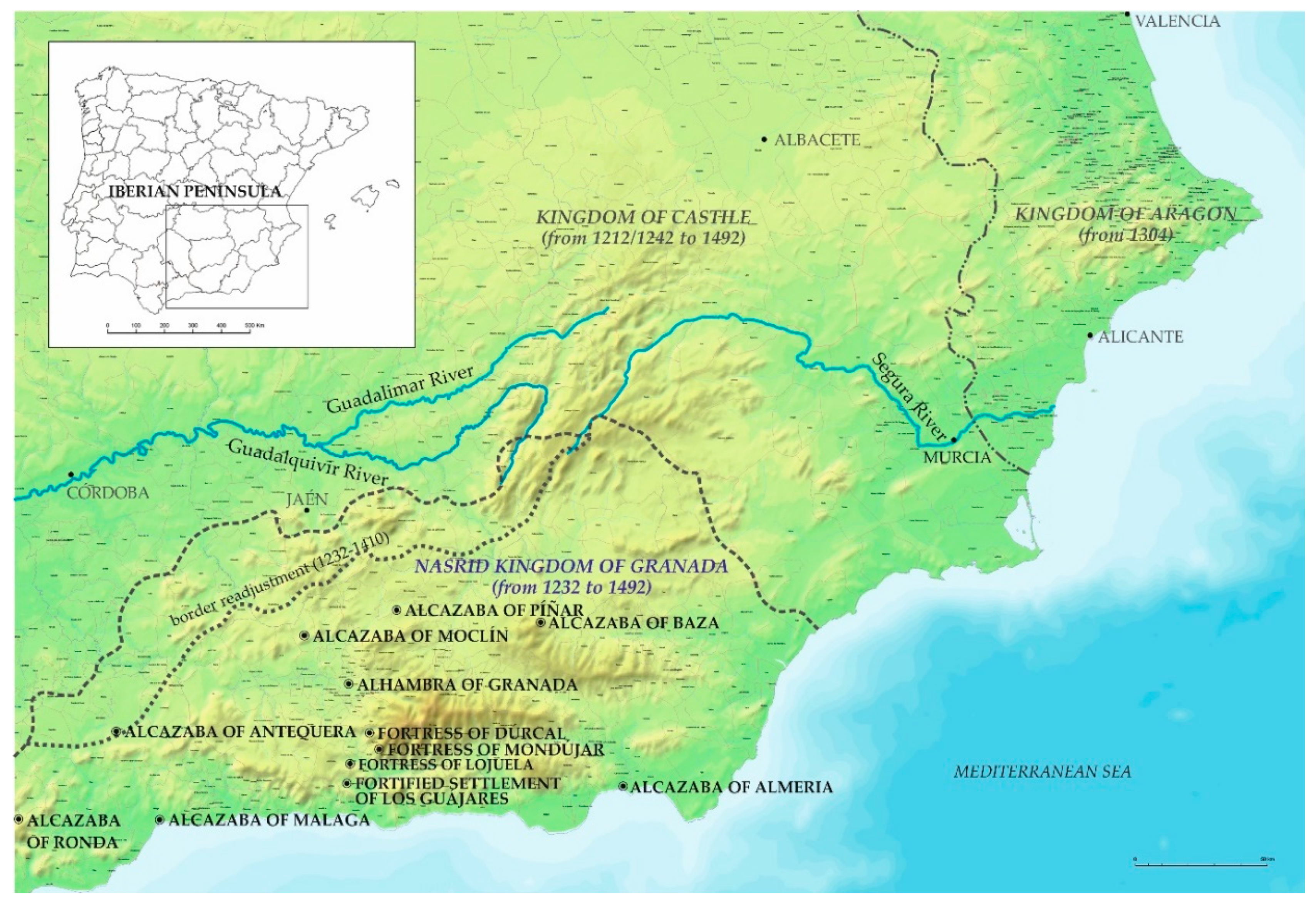
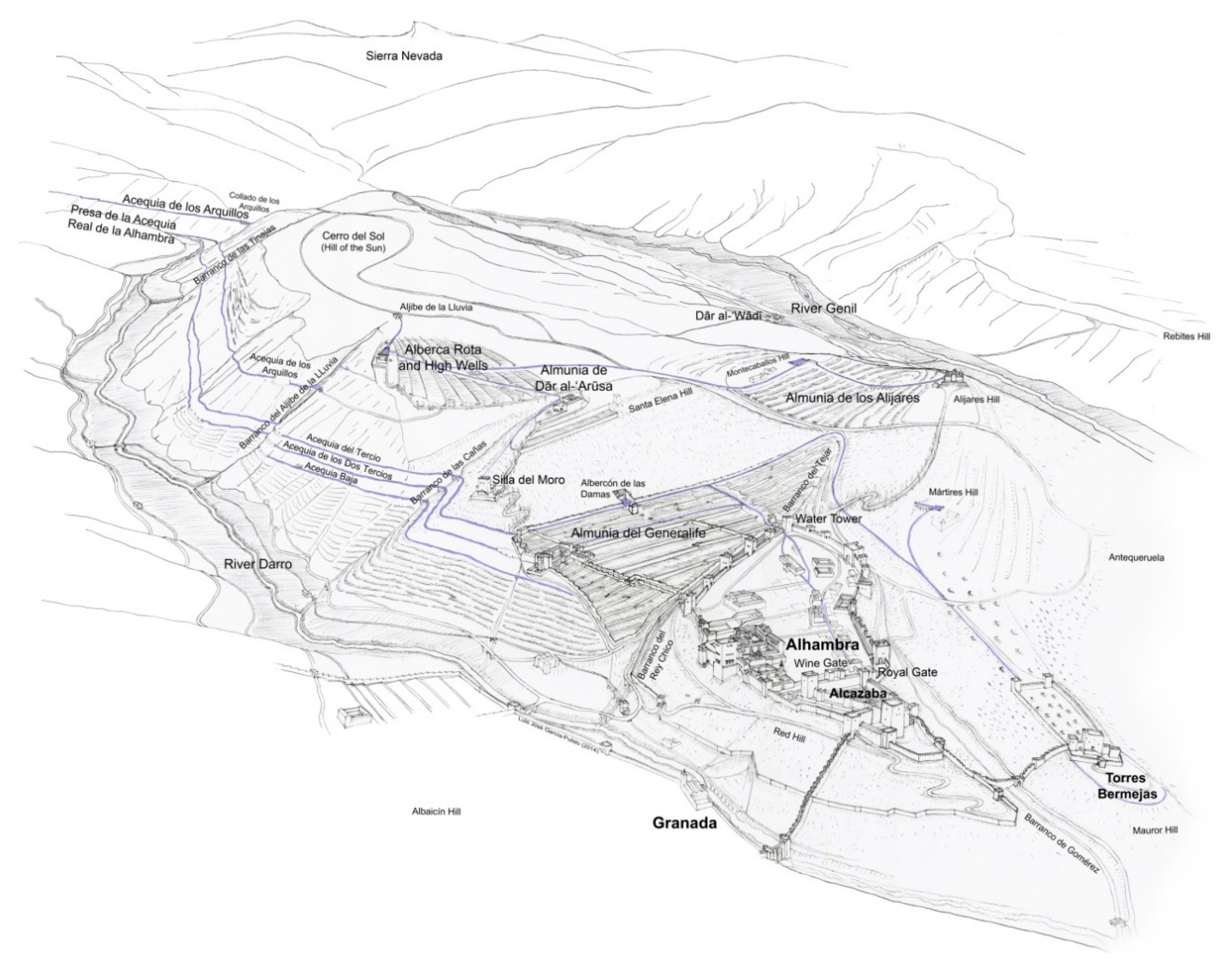

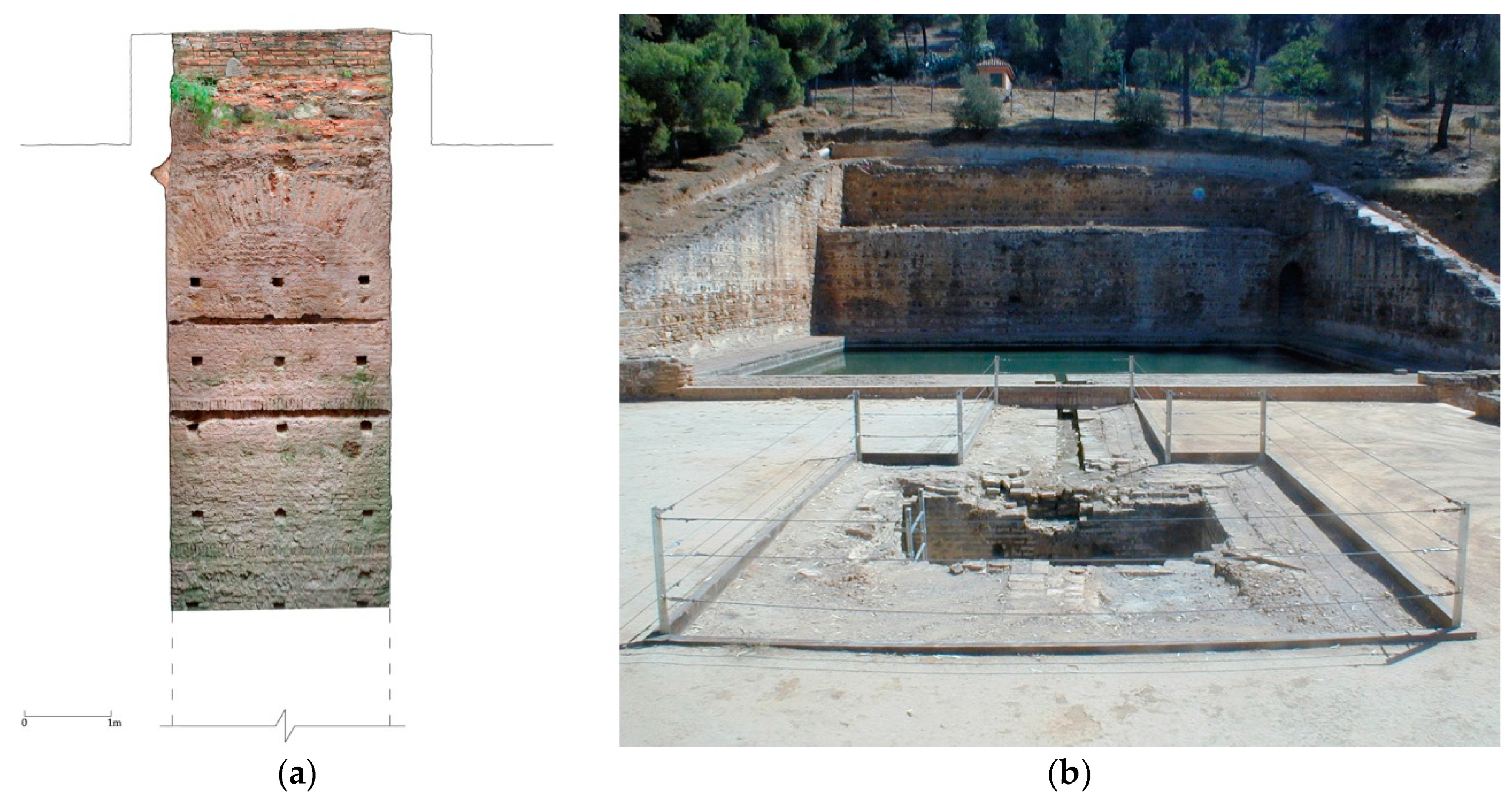
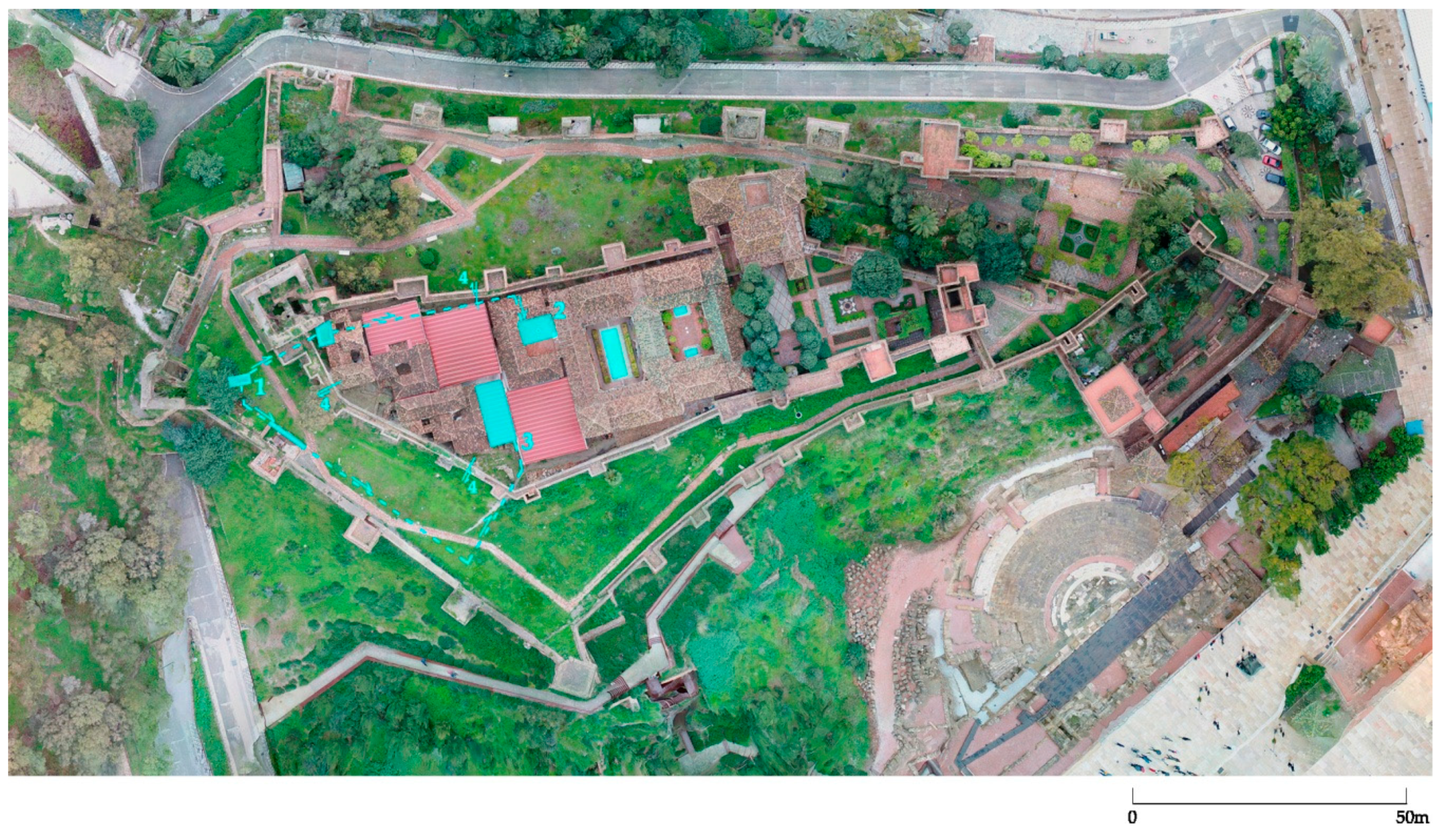
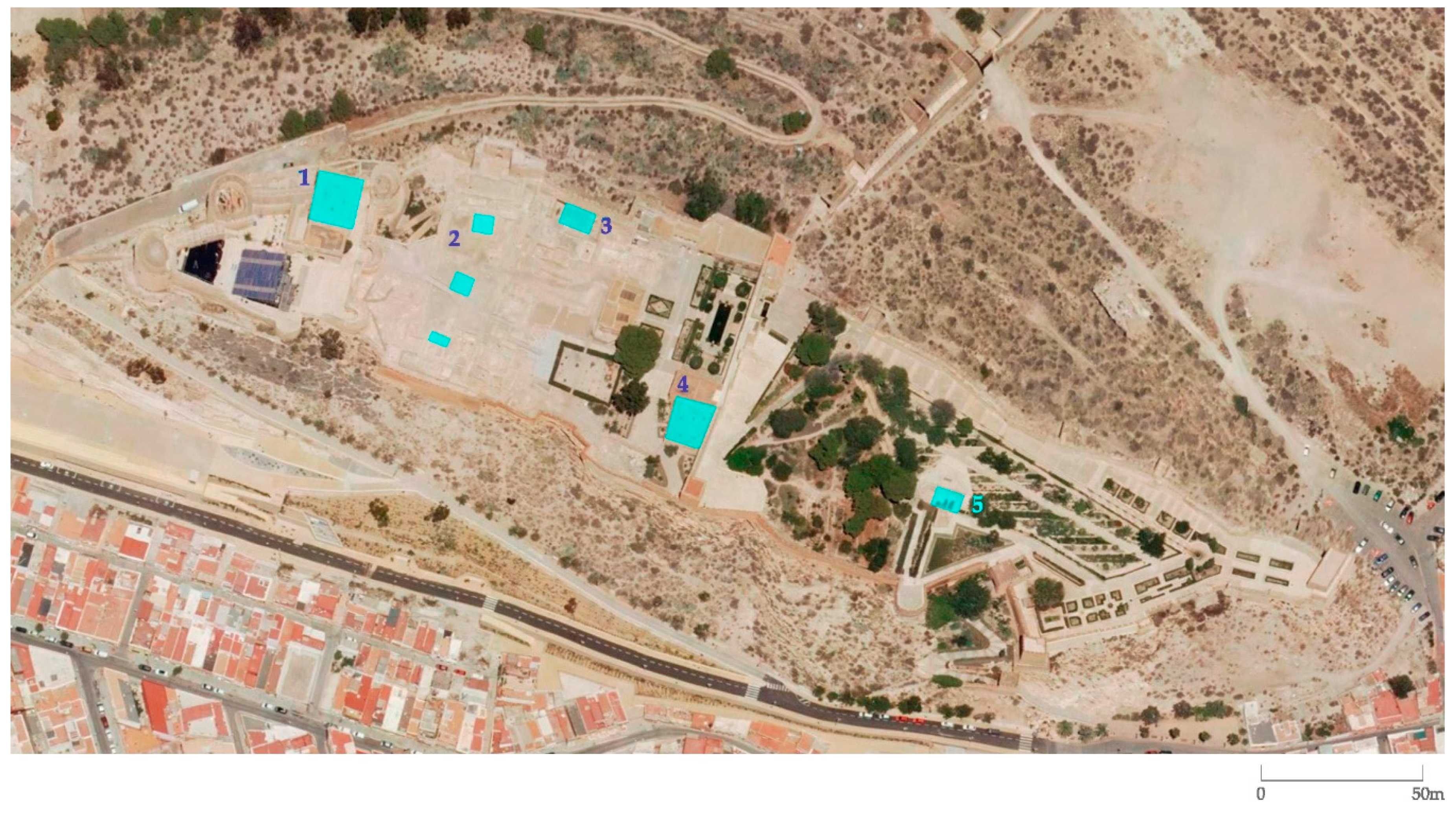

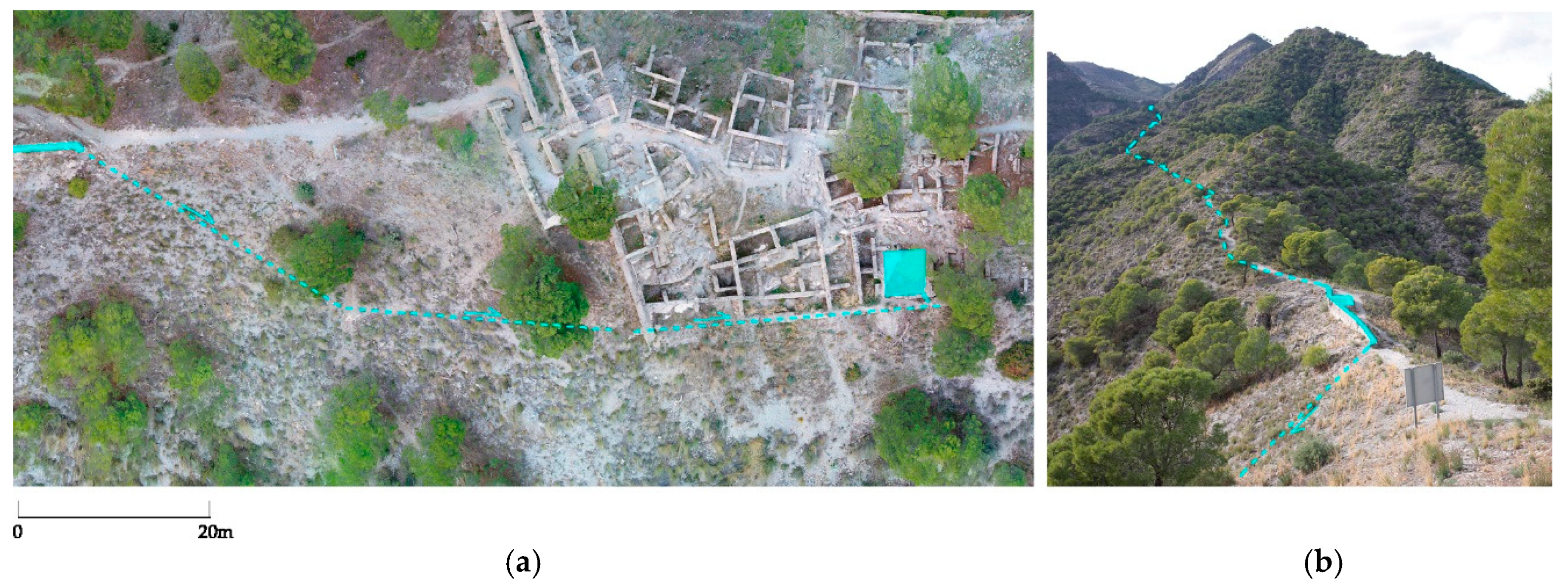
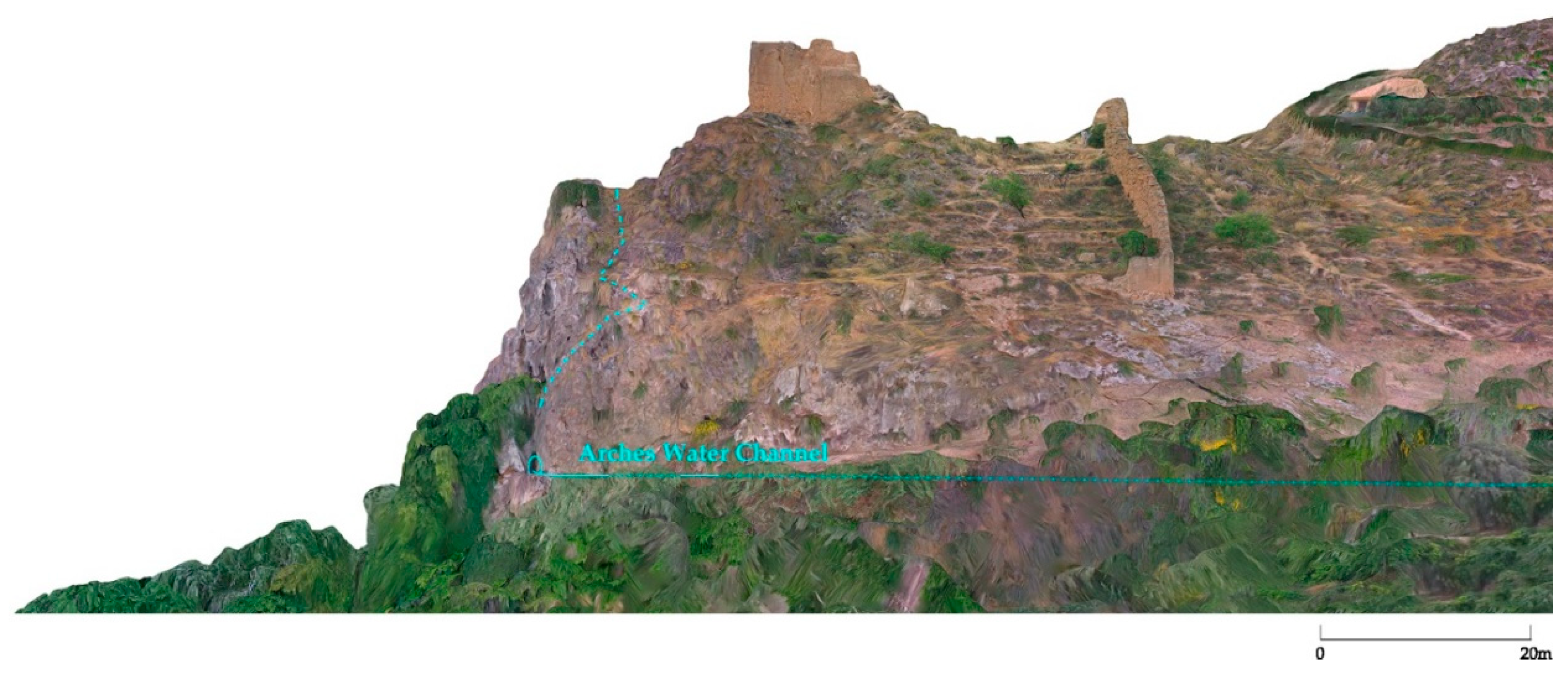
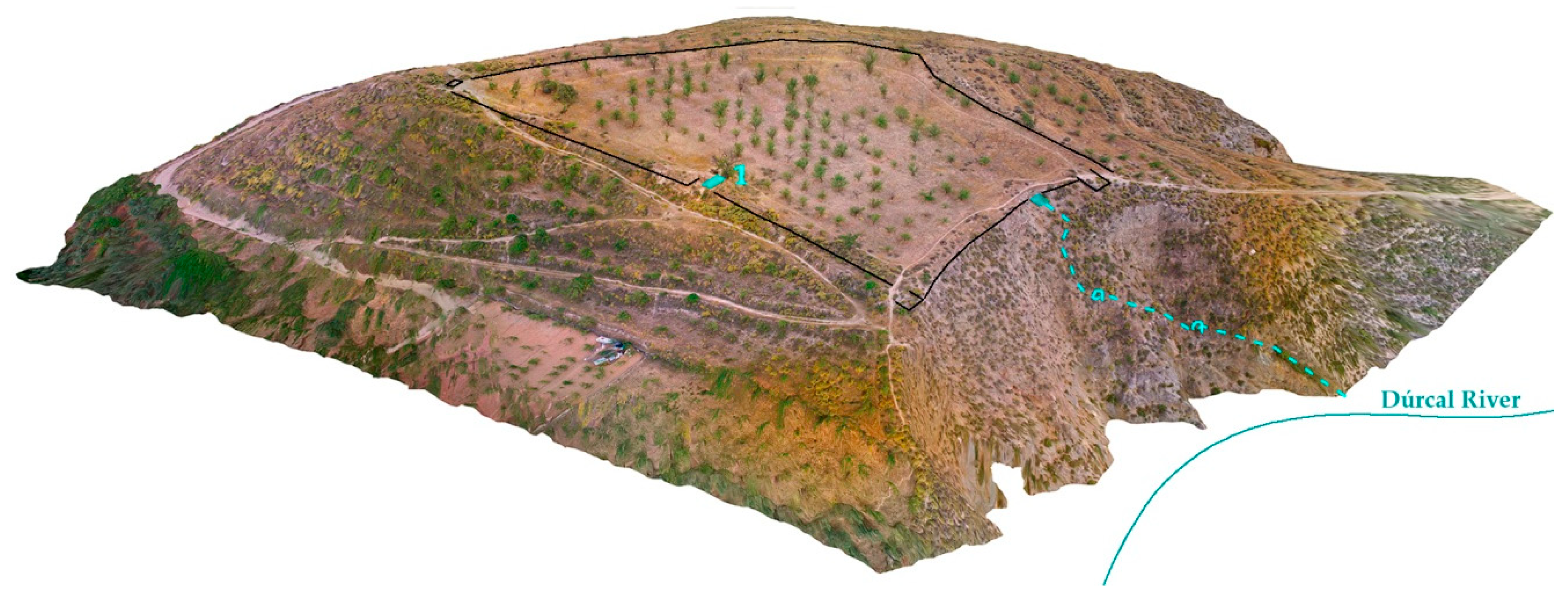
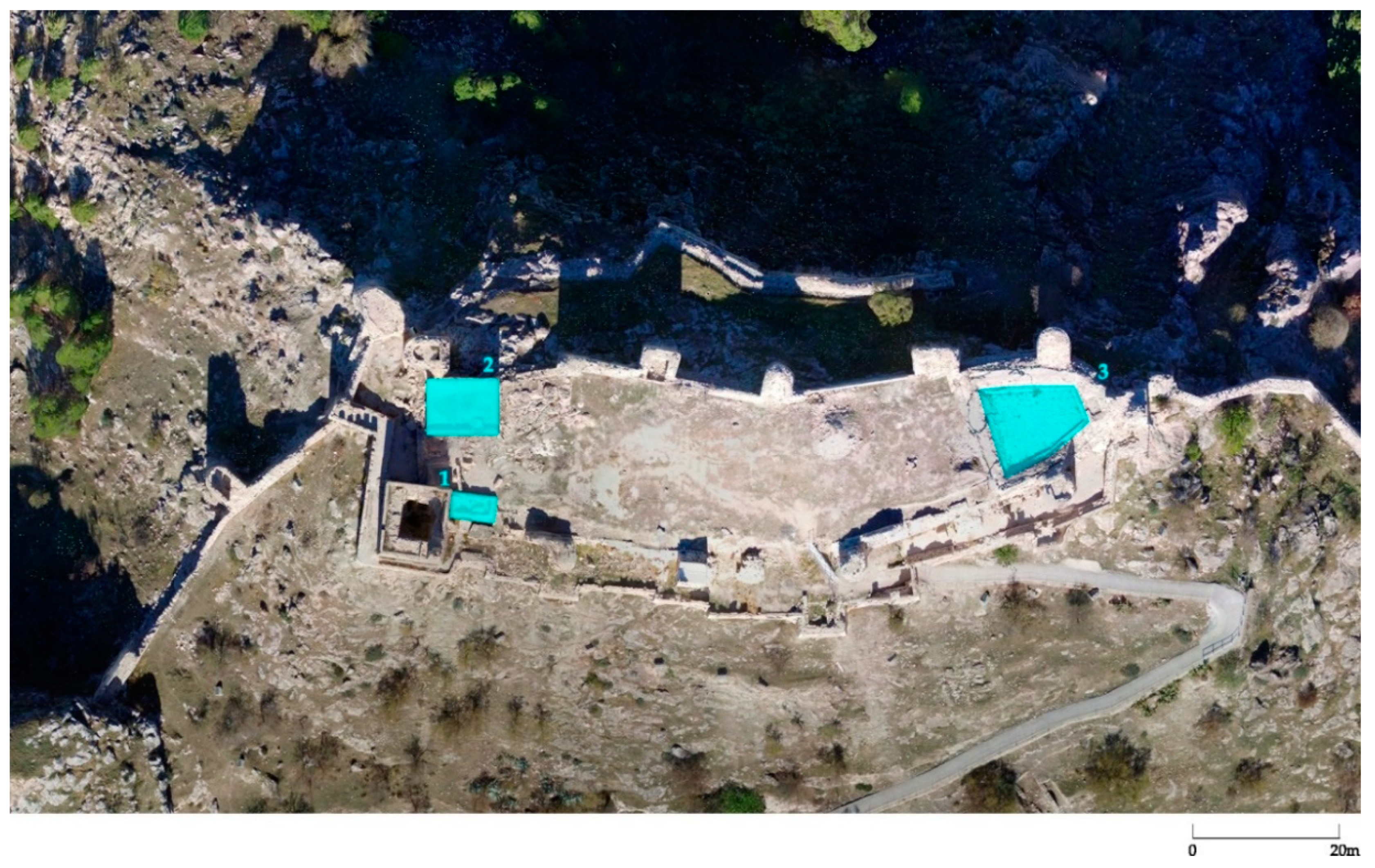
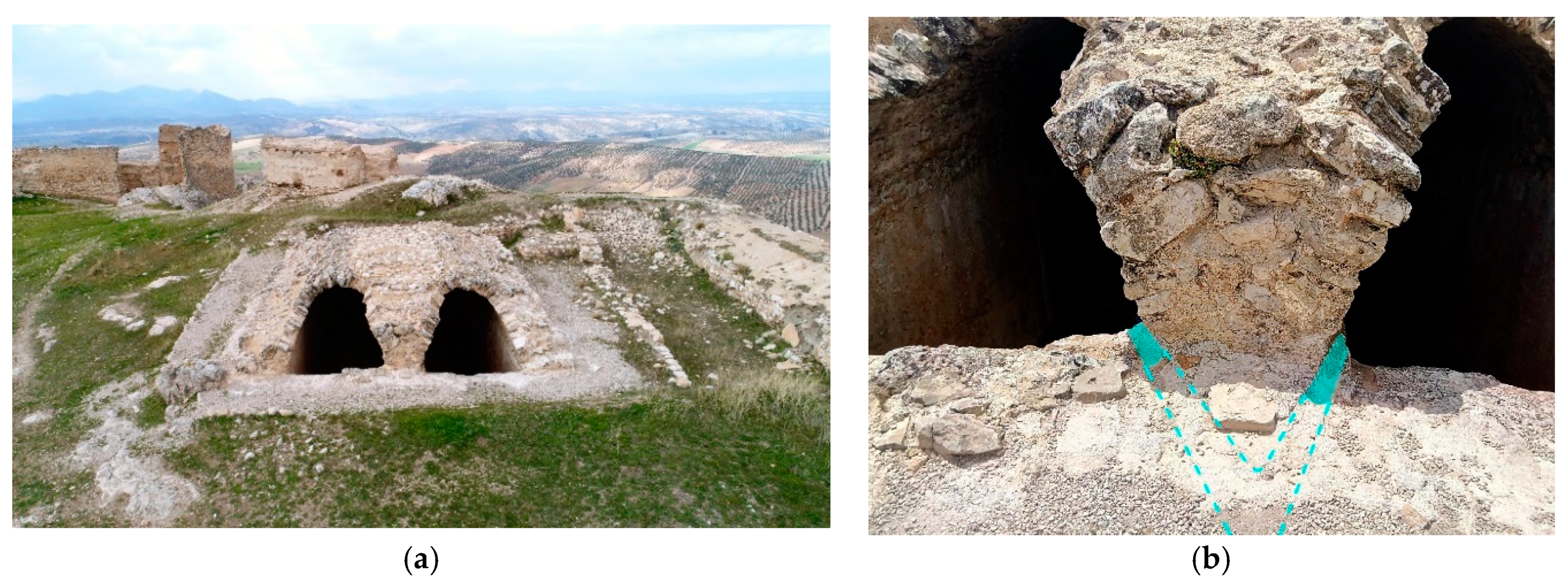
© 2019 by the authors. Licensee MDPI, Basel, Switzerland. This article is an open access article distributed under the terms and conditions of the Creative Commons Attribution (CC BY) license (http://creativecommons.org/licenses/by/4.0/).
Share and Cite
García-Pulido, L.J.; Martín, S.P. The Most Advanced Hydraulic Techniques for Water Supply at the Fortresses in the Last Period of Al-Andalus (Thirteenth to Fifteenth Century). Arts 2019, 8, 63. https://doi.org/10.3390/arts8020063
García-Pulido LJ, Martín SP. The Most Advanced Hydraulic Techniques for Water Supply at the Fortresses in the Last Period of Al-Andalus (Thirteenth to Fifteenth Century). Arts. 2019; 8(2):63. https://doi.org/10.3390/arts8020063
Chicago/Turabian StyleGarcía-Pulido, Luis José, and Sara Peñalver Martín. 2019. "The Most Advanced Hydraulic Techniques for Water Supply at the Fortresses in the Last Period of Al-Andalus (Thirteenth to Fifteenth Century)" Arts 8, no. 2: 63. https://doi.org/10.3390/arts8020063
APA StyleGarcía-Pulido, L. J., & Martín, S. P. (2019). The Most Advanced Hydraulic Techniques for Water Supply at the Fortresses in the Last Period of Al-Andalus (Thirteenth to Fifteenth Century). Arts, 8(2), 63. https://doi.org/10.3390/arts8020063



